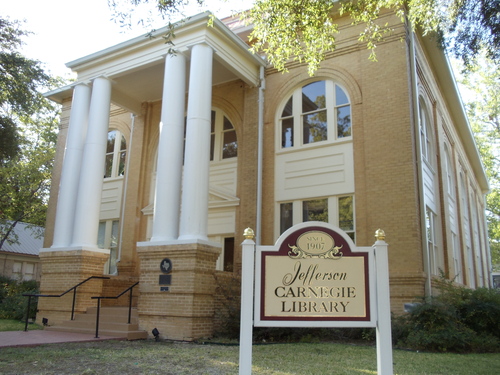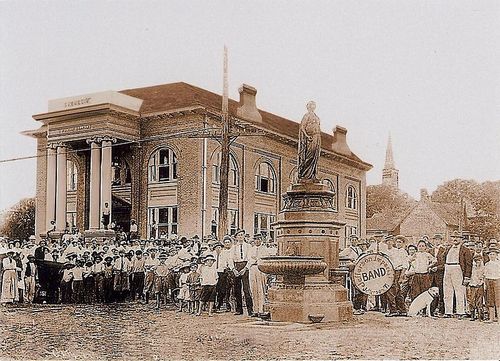.jpg) Jefferson Carnegie Library
Jefferson Carnegie Library
By Jeff Campbell
In Jefferson folks can not only sleep in historic homes and hotels, shop and dine in historic buildings but even a trip to a the library can be a historic experience. The Jefferson Carnegie Library was built in 1907 and was financed by Andrew Carnegie.
Andrew Carnegie was a Scottish American entrepreneur, businessman and philanthropist. Carnegie had acquired his wealth through the steel industry. He was born in Dunfermline Scotland, a son of a handloom weaver, on November 25th, 1835. In 1848 a great economic depression swept over Scotland and the Carnegie family immigrated to the United States, in the Pennsylvania area.
At the age of 12, Mr. Carnegie started work in an area cotton factory, while he attended night school to continue developing his education. At age 14 he accepted a position with the Pittsburgh Telegraph office as a messenger boy. One of the superintendents of the Pennsylvania Railroad, Thomas A. Scott was so impressed by Mr. Carnegie's work ethic he hired him as his secretary.
After the upheaval of America's Civil War, Mr. Carnegie succeeded Mr. Scott as a superintendent with the Pennsylvania Railroad. A shrewd investor, Mr. Carnegie became involved with several iron mills, factories and the Woodruff Sleeping Car Factory. By now a very rich man, Mr. Carnegie made periodic trips to Great Britain where he studied the rapid changes developing in the iron industry. Mr. Carnegie had the foresight to realize that steel would soon replace iron in the world of heavy manufacturing. He founded Carnegie Steel Company, which would later merge with other companies to form U.S. Steel.
Unfortunately Mr. Carnegie built his empire on low wages and union busting techniques. The most well known incident during this time was the Homestead Strike of 1892. When the Amalgamated Association of Iron and Steelworkers went on strike, at Mr. Carnegie's plant in Homestead, Pennsylvania, the Pinkerton National Detective Agency was called in to break it up. In the aftermath of a gun battle, nine ironworkers and three Pinkerton agents lay dead.
Perhaps this incident and others are what led Mr. Carnegie to become a philanthropist. Late in his life Mr. Carnegie made a case that it was the duty of rich men and women to contribute to the welfare of the community by the use of their wealth. He wrote that a "man who dies rich dies disgraced". When Mr. Carnegie passed away, on August 11th, 1919, he had donated over 350 million dollars. Allowing for inflation that would amount to over four billion dollars in today's economy.
Between 1883 and 1929, 2,509 Carnegie Libraries were built worldwide, with 1,689 being built in the United States. 32 of those libraries were built in Texas. Only 14 of the libraries are still standing today, with only four of those still serving their original purpose. The Jefferson Carnegie Library is the sole surviving Carnegie Library in East Texas functioning as a library. Without Mr. Carnegie's assistance the Jefferson Library may have never been built.
To have a library constructed towns had to follow what came to be known as the "Carnegie Formula". The town had to supply a matching contribution, demonstrate the need for a library, provide a suitable building site, annually supply ten percent of the buildings construction cost to support its operation and provide free service to all.
At the turn of the century the citizens of Jefferson were seeking opportunities to return the city to the high- profile it once enjoyed when the grand steamships made their way to Jefferson from New Orleans. This was before the Great Raft on the Red River, a logjam that created a dam, was cleared by the Corps of Engineers in 1873. With the Great Raft gone the level of Caddo Lake receded, as did Jefferson's fortunes. Steamships could no longer traverse Caddo Lake. A new library appeared to be just the ticket to return the city to its former glory.
The contract to build the new library was given to J.F. Berry of Morris County. The library was built in a neoclassical style of architecture out of native limestone.
The Jefferson Jimplecute, our local newspaper which is still published weekly, was greatly enthusiastic about the endeavor: "In the good old town of Jefferson, which has figured more in the formation and upbuilding of teeming Texas than most any other city...the town is again assuming its sway of ancient supremacy as a leading city and center of a superbly rich county in Northeast Texas."
Through the years the library not only served its primary function but the second floor was also used as a youth center, class room, dance studio, Red Cross location, government office and flood relief headquarters.
By 2005, with the library's 100th anniversary quickly approaching, the structure was showing its age and needing restoration. The ceiling was drooping, historic wood windows were weather-beaten and under the floor rot had taken its toll on beams and joists. Using the library was also a challenge for handicapped patrons, as it was not ADA (Americans with Disabilities Act) compliant.
The Friends of the Jefferson Library rolled up their sleeves and went to work. Over $500,000 was raised by the Friends of the Jefferson Library for the restoration project. Not one penny came from Federal, State or local funding.
After the library's collection and contents had been moved to a temporary location the restoration work began. The building was made ADA compliant and a new elevator was installed. Steel stress cables secured the drooping ceiling above and the building's foundation was stabilized below. Rotten joists and beams were replaced to level the new hard wood flooring. Although the wood frames of the windows had to be replaced the original glass was saved. New landscaping enhanced the building site and repairs to the metal roof topped off the project.
By 2007, on the library's 100th anniversary, the Friends of the Jefferson Library had met their goals and the library reopened. Since the library is not owned by the city, the Friends of the Jefferson Library's work is ongoing for upkeep and maintenance of the library. Applications to join the Friends of the Jefferson Library are available at the library.
Today the library not only offers books, videos and audio books for checkout but also offers copy and fax services. The library also has wireless internet access and computers with internet connections.
If you're looking to hold a special event, the magnificent upstairs ballroom, with its graceful arched windows and oak wood floors, is available for rental. There is a full, spacious elevator for guests and equipment access.
The library, whose phone number is 903-665-8911, is located at the corner of West Lafayette Street and North Market Street. It is open from 10:00 AM to 6:00 PM, Monday through Thursday, Friday from 10:00 AM to 5:00 PM and Saturday from 10:00 AM to 3:00 PM.
As you visit Historic Jefferson, Texas, hopefully you can take a little time to visit our library, there's more to check out than just a book.

